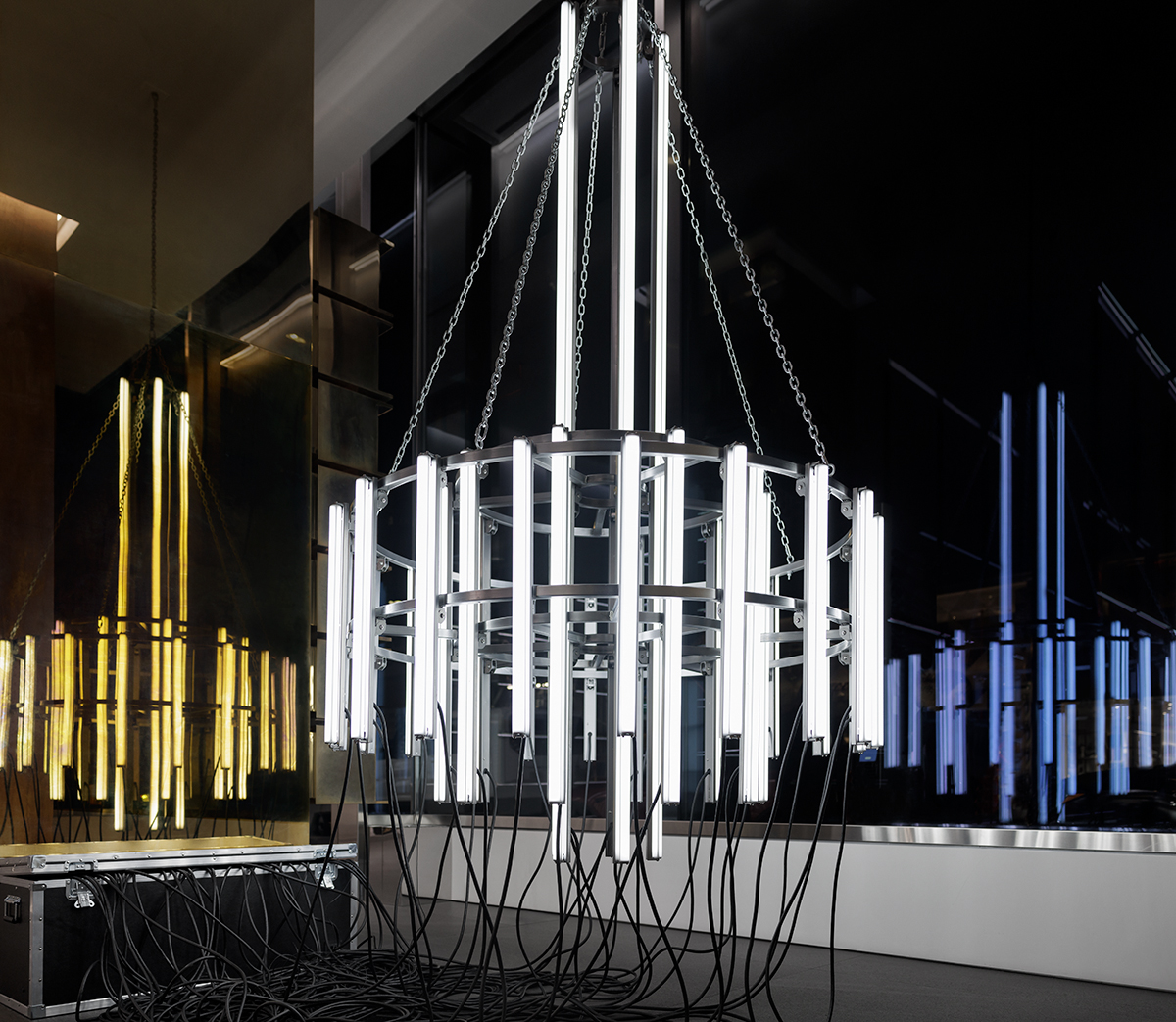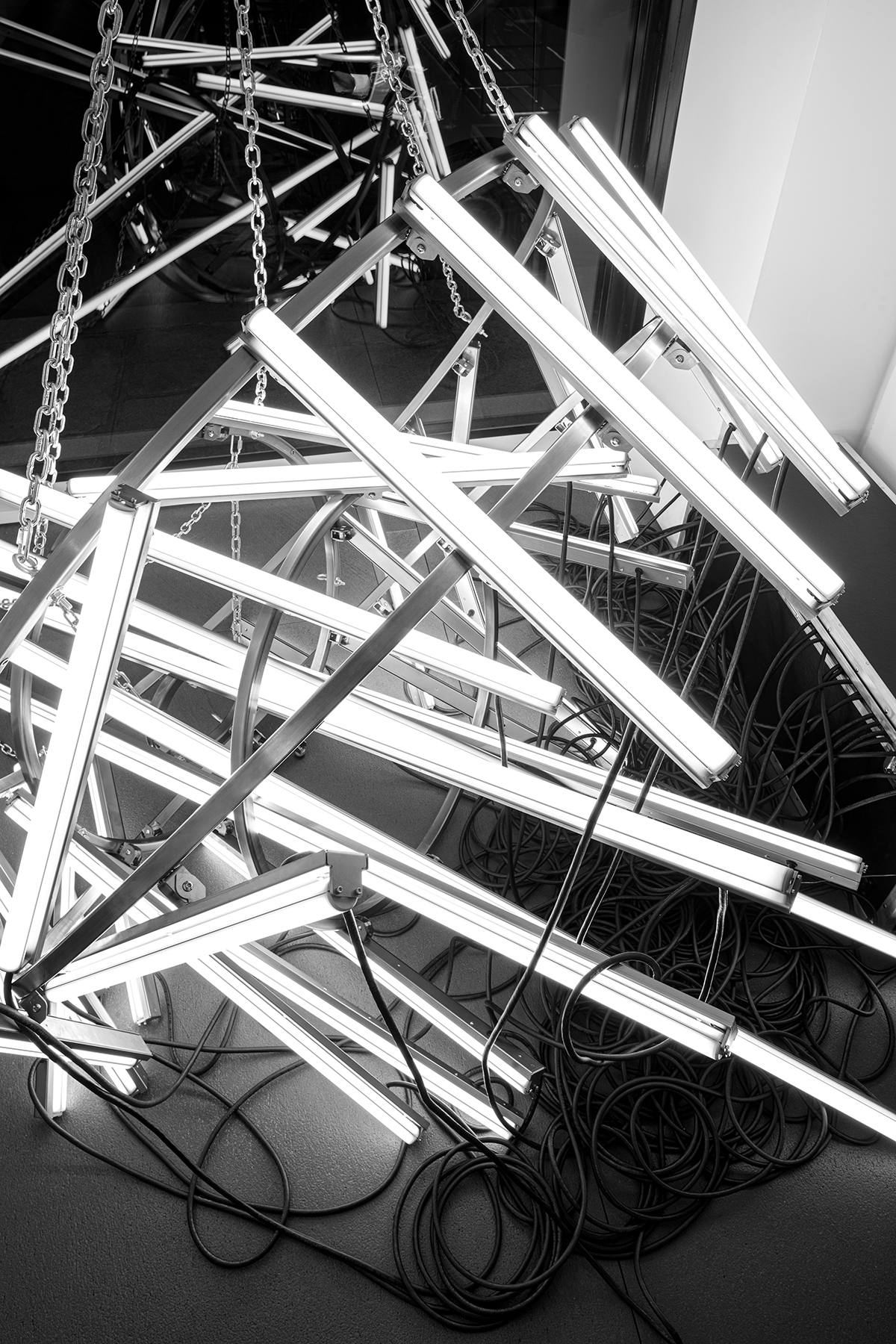
A beaming chandelier swings at Tokyo’s luxury mall Ginza Six—it then proceeds to ascend on a vitrine overlooking the pedestrian-beaten Madison Avenue in Manhattan; a complete collapse ensues at a boutique corner on Milan’s cobblestoned Via Montenapoleone. From glorious suspension into dignified downfall, the fixtures neither cease lightening nor lessen in flamboyance: chunky in their spatial occupancy, the chandeliers elegantly sprawl their bulbs, cords, and chains in retail spaces.
“Cells from a strip of film,” Banks Violette calls his fourteen chandelier sculptures on view at various Celine boutiques across the globe. In the operatic journey of a hefty chandelier giving into gravity’s call, each unique structure captures another sliver in time, “If you put them together,” he explains to Elephant, “you would watch this object crash in real time—but instead you are seeing stills.” The artist likens the globe-spanning project that stemmed from Hedi Slimane’s invitation to “reading a chapter of a book without the rest of the book itself.” The upstate New York-based artist and the 78-year-old fashion house’s creative director met around 2004, and they have since collaborated on a 2007-dated group exhibition titled Sweet Bird of Youth and, most recently, on the brand’s Autumn/Winter 2022 menswear collection.


The sculptures at different boutiques claim different instants of entangled temporality, herds of countless LED sticks piling into muted audial explosions. Coordinated chains unite the lights while wires that are “big and thick” snake into the chandeliers on one end and culminate inside neat trunk cases on the other. “Any form of subculture-making I am drawn to,” admits Violette, “even if that is a backpack that a teenager decorated with Sharpies.” He finds himself fascinated by the “ephemeral aspect of music with steps of thinking, making, and staging,” which eventually “disappears.” The aftermath effect in his work—as much as a feeling of ungraspable materiality—perhaps rises from this begging of music for transcendental devotion despite its effervescent rush. “The real world creeps in” with lines of wires gushing out of his sculptures, “and I allow the fiction to be a fact.” He finds a thrill in seeing something—“theatre, concert or anything really”—being produced “to create an effect” with its tools exposed, “but that effect still conveys a transcendence.”
Like the revealed constituents and the timezone-defining journey of his chandeliers, Violette has had many lives himself. He emerged in New York’s downtown art circuits during an era bookended by two polar fascinations: post-9/11 mortality and pre-Facebook self-indulgence. In the early 2000s, he and his peers—including Dash Snow, Dan Colen, Ryan McGinley and Nate Lowman—delivered visually and emotionally trippy work, both marred and adorned by music and escapism, seeped by heavy drugs and a zealous art market. Life in constant trance yielded art for Violette, who was then a recent Columbia MFA graduate, who excavated the state of letting go and the gnarly search for the immaterial. The psychedelic epiphanies led to paintings and sculptures that were not only optically heavy in black but also in subject matter—grotesque and goth; Violette’s works starred in shows with their seductively sleek take on dark Americana as well as very American kinds of precedent art, mainly 1960s’ Minimalism and Land Art. Elegantly scattered instruments and smashed stages with allusive compositions found their way into museums in the United States and Europe. In 2005, at age 32, he had a solo show at the Whitney Museum of American Art, spearheaded by a mammoth sculpture inspired by a Norwegian church burned by black metal fans.

Charred is absent in Violette’s sculptures today, and luminosity instead cuts through the dark. A crescendo awaits in the suspension while the encore runs in its ceaseless loop. “An object is a surrogate for yourself out in the world with collapse and falling,” the 50-year-old says but notes that “the autobiographical is never his intention.” He rather sees the “equally glamorous and disillusioned states” in his chandeliers embodying multiple stages of disarray. Fashion, like music, he thinks, “offers that contingent moment in which you put yourself out in the world.” The innate corporeality of sculpture, however, is a physical reality Violette cannot deny in relation to the body: “The primary increment you have to measure and evaluate something with is your own body—sculpture extends itself into your space and becomes coextensive with your existence.”
Banks Violette’s sculptures will remain on view at fourteen Celine stores across the globe through the end of January 2024.
Words by Osman Can Yerebakan





